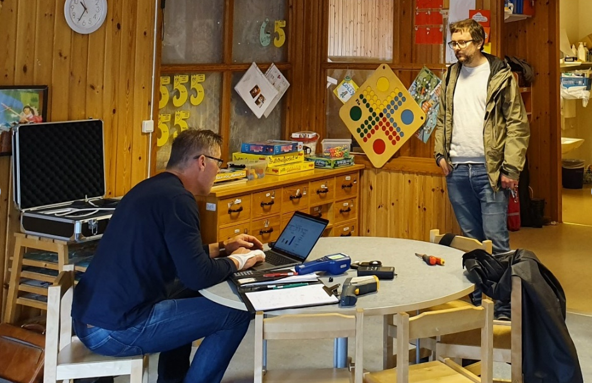How can we build smart and keep both energy efficiency, our health and well-being in mind? A key factor is awareness and knowledge among real estate companies and politicians, who make the decisions regarding procurement for rebuilding and new constructions.
The County administrative board of Dalarna therefore decided to map the indoor climate in schools in four of our municipalities.
In addition to interesting information for the participating municipalities, we gained important insights for the seminars we subsequently conducted and knowledge when we next year will design and formulate our planning tool/guide for good indoor climate in school buildings.
Mikael Larsson, property manager at Gagnef municipality, explain the importence of continuous measurement and comments on the measurements made in Gagnef:
– For the municipality, measurements are very important to ensure a good working environment for staff and children. The measurements have led to both operational, energy saving and environmental related actions.
Parameters measured were for example room temperature, relative humidity, air turbulence, CO2, noise level, light and particles.
Below the tools we used and a picture of the Air quality monitor.

Overall experience from four municipalities in Dalarna
Temperature
– Usually high temperature problems occur during summer months. Our experience from the measurements shows that ventilation is usually not the problem, but instead the temperature in the premises. The limit value of 1000 PPM CO2 was never exceeded in any of the measurements.
 A study called Assessing Indoor Climate and Occupant Productivity, by Konstantinos Vretos
A study called Assessing Indoor Climate and Occupant Productivity, by Konstantinos Vretos
KTH 2017, show the relationship between relative performance and temperature. The slope of the curve indicates that every 1°C change (increase or reduction) of temperature from the reference point 22 °C corresponds to a decline of performance by almost 1%.
http://kth.diva-portal.org/smash/get/diva2:1161191/FULLTEXT01.pdf
Indoor air quality
– Dry air is a major problem during winter season in Sweden because of too much ventilation and/or particles. High levels of particles also bind moisture, which is vented away.Experience from our measurements shows that during certain periods of high activity in the premises there are high values of both small and large particles. Even when measurements show low values of PM 1, PM 2.5 and PM 10 (μg/m³), the content of the smallest particles (0.3 μm), is high in number (millions/m³) in most of the school measurements we have made. See diagram below – appendix 1
Lighting
– Not enough light in classrooms gave low lux values. We saw many old installations and dark interiors that dim the light in the room.
Acoustic– Too much noise from ventilation in many rooms. Causes may be incorrectly designed air flows and sound attenuation in ducts as well as incorrect type of flow devices.The design of the interior is also of great importance for the sound level in the rooms
Our recommendation is to measure more than once and during longer periods because conditions differ depending on season (pollen, temperature) and ventilation solution.
An interesting study In November 2018 a study was published by the Buildings Performance Institute Europe (BPIE) showing how poor indoor environmental quality, can affect student’s health, attendance, concentration and learning performance.
In November 2018 a study was published by the Buildings Performance Institute Europe (BPIE) showing how poor indoor environmental quality, can affect student’s health, attendance, concentration and learning performance.
Screenshoot: http://bpie.eu/wp-content/uploads/2018/12/BPIE_methodology_031218.pdf
Effect of temperature
The BPIE report identified six studies that provided a correlation between certain temperature ranges and students performance. The summery of these studies reveals that: Every 1°C reduction in overheating increases students learning performance by 2.3 %.
Effect of indoor air quality (In the BPIE report, CO2 concentration is used as an indicator of indoor air quality).
In summary the Effect on performance was: For every 1 litre per second per person (l/s/p) increase in the ventilation rate up to 15 l/s/p, academic performance increases by 1%. In summary the Effect on absenteeism was: Every 100ppm decrease in CO2 concentration is associated with a 0.5% decrease in illness-related absence from schools.
Effect of lighting In order to compare different studies with different results, the report standardised the performance improvement as follows:Every 100 lux in improved lighting in schools is associated with a 2.9% increase in educational performance.
Better daylight is associated with a 9% to 18% increase in educational performance.
Effect of acousticsFor every 1 dB decrease in excess noise, academic performance increases by 0.7%
Ventilation system with filter really mattersDust acts as a reservoir for a variety of harmful agents. It can be outdoor particles that penetrate indoors, viruses, bacteria, chemicals, allergens (pets, mold spores, pollen), building materials, fabric fibers, and paint with lead.
In the report Schools for Health (https://schools.forhealth.org/) produced by the Healthy Buildings program at the Harvard T.H. Chan School of Public Health, the authors present the effects of student health, thinking and performance.
Students cannot perform well if they are not present physically. The presence of visible mold, humidity and poor ventilation were all independently associated with absenteeism in a study of schools in New York State (Simons 2010).
In another study of over 1000 students, the concentration of molds in floor dust was associated with concentration problems, headache and dizziness (Kim 2007). Similar impacts were observed in studies of teachers. In a study of 500 New York State teachers, the most commonly reported allergens and irritants were dust and dust reservoirs, followed by moisture problems.
An ongoing American research program MA SMART https://research.forhealth.org/2017/03/06/ma-smart/ compares surrounding greenness and ambient air pollution to chronic absenteeism rates, defined as the percent of students that missed 10% or more of the school days in an academic year. Schools with more surrounding greenness, were found to have lower absenteeism rates. A similar trend was found with particles concentrations: a 1 µg/m3 increase was associated with a 1.58% increase in chronic absenteeism rates.
Example from our mapping at Marcus school in Avesta – April 2019This example below shows clearly how important a good ventilation system is, especially for very small particles. We compare two classrooms. Classroom 324 with a ventilation system with heat recovery and a PM1 filter and classroom 329 without filter. The difference between the two rooms are for particles 0,3 µm 39%. The particle reduction of particles 0.3 µm/m³ between outdoors and indoors in classroom 329 is 19% according to the chart on this measurement occasion. Compared with 50% in room 324. You can clearly see that particle concentration increases with higher activity and more persons in the classroom. At this measurement occasion it was very high particle concentration in the outdoor air.

.png)
In Sweden we have limit values for outdoor air, aimed at protecting human health, but not for indoor air, only guidelines. For example:PM 2,5 25 μg/m³ (day) and 12 μg/m³ (year).PM 10 50 μg/m³ (day) and 40 μg/m³ (year)The municipalities are responsible to verify that the environmental quality standard is met.
In the pictures below we show the differences between the two classrooms in comparison with recommended values. Changing ventilation system has greate saving potential. Example from Enåbacken elderly home in Rättvik. In an elderly home in the municipality of Rättvik we saw from the measurements before and after changing ventilation system that energy consumption from the ventilation units has dropped by an average of 58% after the conversion. Total savings from three units estimated to 6400 dollars per year.
The degree of particle separation between outdoor air and supply air also increased for the better by 10% after the conversion of the ventilation units.
Price: 1 Kwh = 1 SEK

About EFFECT4buildings:
EFFECT4buildings is implemented with the support from the Interreg Baltic Sea Region Program 2014-2020 (European Regional Development Fund) and Norwegian national funding. The aim of the project is to improve the capacity of public building managers in the Baltic Sea Region by providing a comprehensive decision-making support toolbox with a set of financial instruments to unlock the investments and lower the risks of implementing energy efficiency measures in buildings owned by public stakeholders. For more information: http://www.effect4buildings.se
Text author: Hans Ahlin, EFFECT4buildings, Länsstyrelsen Dalarnas län













